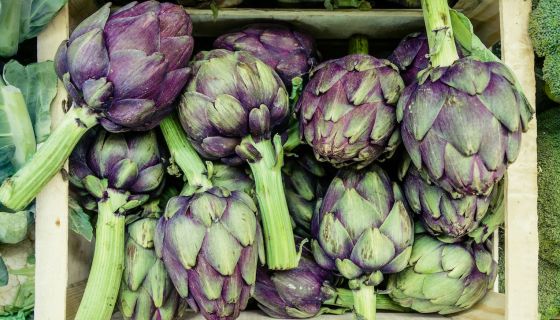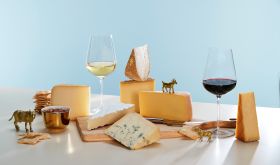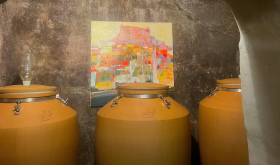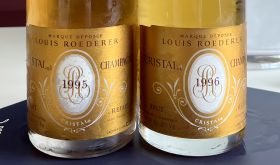Food-and-wine matching, or pairing as it’s often called, has become an increasingly popular sport. I admire the practitioners, while being far from hardline on the subject myself.
I feel wine itself is complicated enough and have always been reluctant to add an extra layer of complication in what I write. In practice, I find it’s possible to drink virtually any wine with any food and if there really is a bit of a clash, then usually it can be mitigated by taking a mouthful of water and/or something neutral or absorbent such as bread in between mouthfuls of the food and the wine.
But I know some people are anxious about food-and-wine matching and others take great pleasure in finding perfect pairings. The only circumstances in which I expect pairing perfection is in a tip-top restaurant with a professional sommelier who should know the dishes well enough to be able to recommend an ideal wine at three different price levels.
But there are some foods that distort the palate to such an extent that they really are extremely difficult to match with wine.
Globe artichokes are the most obvious example. They have the immediate effect on most people of making things taste oddly sweet and metallic. As Victoria Moore points out in her comprehensive guide to pairing, The Wine Dine Dictionary, when you’re eating a globe artichoke leaf by leaf, it’s such a demanding process – and the leaves themselves are quite juicy – you don’t really need to drink anything with it.
Grilled artichoke hearts, a deli delight, aren’t quite as palate-deforming. Moore recommends wines with texture: orange wines, slightly bitter Italian whites or a light, pale sherry. I’ve tried all these and found a manzanilla and fino went beautifully, especially one of the unfiltered, young, en rama versions. Riesling was a real clash.
We’re in the middle of the season for asparagus, another vegetable accused of being difficult to match with wine. There’s a doctrinal divide between asparagus connoisseurs. For Germans, asparagus has to be fat and white, and the conventional partner is dry (trocken) German Riesling or Silvaner, the characteristic wine grape of the Franken region south-east of Frankfurt that is widely underestimated. Rudolf May makes a range of beautiful Silvaners, many of which are imported into the UK by Howard Ripley.
For most Brits, asparagus should be bright green and thinner. It too can go well with a dry German Riesling, of which there is such a choice nowadays. Dr Bürklin-Wolf’s brilliant, biodynamically grown Pfalz Weissburgunder (Pinot Blanc) trocken 2022 also worked beautifully with English asparagus. It’s available in the US for as little as $23.99 but is not, unfortunately, on sale in the UK. German wines tend to usefully low in alcohol, too.
Sauvignon Blanc is often considered a suitable accompaniment for green asparagus. Lesser or older New Zealand Sauvignon Blanc can itself taste of canned asparagus. But for this essentially spring-like vegetable, I think a really fresh Sauvignon-like wine is preferable. Many a Friuli dry white has a certain ‘greenness’ to its flavour. Those with Sauvignon or Friulano grapes in the mix can be a good friend to green asparagus.
Rosé, which can be a particularly versatile food partner, especially in restaurants when people have ordered different dishes, doesn’t work with asparagus, perhaps because of its relatively low acidity.
Another obvious enemy of wine is chilli and other red-hot spices that assault, even numb, the palate. Lager does its cooling work well, arguably better than water. But if it has to be wine, a sweetish, bold red such as those listed below can work better than more classic, structured, dry reds that taste even more austere once the palate has been bludgeoned by a highly spiced dish. Really fruity whites can work, too.
Wine and cheese is seen as a sacrosanct combination. Americans often serve it before a meal, Europeans towards the end, or as a light meal on its own. Whether before or after a dessert can be a domestic flashpoint. I favour before because it seems logical to follow a savoury main course with something savoury before ending with something sweet. Traditionally red wine has been served with cheese, perhaps just carrying on with the red wine served with the main course (so not calling for a new glass), but many of those who take notice of how food and wine interact argue that white wine is a much more suitable partner.
Just to make things even more complicated, cheeses themselves vary enormously in character and in their impact on the palate. I’d argue it’s almost impossible to find one wine that would go with a really diverse cheeseboard, and that anyway it can be preferable to serve just one cheese in perfect condition – certainly if you seek pairing perfection.
Hard, salty cheeses such as Cheddar, Mimolette and the late Edmund Penning-Rowsell’s beloved Cantal go pretty well with dry reds but white wines are often a better bet with many other cheeses. Sweeter hard cheeses such as Comté, Beaufort, Emmental and Gouda can be better with lively whites – even a full-bodied white burgundy or other Chardonnay. Gouda can make a red wine taste metallic, but goes surprisingly well with a fruity rosé.
Fresh goat’s-milk cheese and Sancerre, or other bone-dry Sauvignon Blanc, is a widely recognised successful combination, and those wines recommended for green asparagus above go well, too. But as chèvre ages, it becomes increasingly salty and probably calls for a richer white. Sweet and salt go well together (think of ham and melon, port and Stilton), as witness the fact that sweet whites are the perfect foil for creamy blue cheeses such as Roquefort. Super-creamy St-Félicien is lovely with medium-sweet wines such as Vouvray, Alsace Vendange Tardive wines or a Riesling Spätlese.
But Gorgonzola, like Brie, Camembert and Baron Bigod from Suffolk in England, is a soft-ripened cheese which presents real challenges for wine pairings. These creamy cheeses coat the palate and, in the case of Brie and Camembert, can sometimes smell of ammonia, depending on their age. Aldo Sohm, the celebrated Austrian sommelier at Le Bernardin in New York, recommends champagne or calvados in his book Wine Simple.
Fiona Beckett, who has specialised in food-and-wine matching, is also a fan of going local, and recommends a good Norman cider or young calvados with Camembert. With Brie and Baron Bigod she suggests a fruity Pinot Noir. I also asked my colleague Tamlyn Currin, who takes a keen interest in pairings, what she recommends. Her suggestion of a fresh, fruity beaujolais worked well when I tried it, as did, rather to my surprise, champagne and similar – though I’m not sure that one wants to inject champagne so late into a menu.
I know that champagne, often dry and tart, is served with dessert in many French households but I’ve never found this a happy combination. Much better with sweet food is sweet wine, but it has to be a wine that is sweeter than the food otherwise the pudding will make the wine taste too acid.
Rather like soft-ripened cheese, chocolate typically coats the palate and can be a real challenge for wine pairing. Any wine served with chocolate has to be really, really sweet and strong enough to stand up to the power of chocolate. Perfect are the vins doux naturels of Roussillon such as Rivesaltes and Banyuls. A new cache of sumptuous Rivesaltes, from 1980 back to 1955, has been unearthed in the cellar of Domaine St-Michel for UK importers Farr Vintners and, eventually, Martine’s Wines in the US. Like Madeira, such wines usefully last for months in an opened bottle, which can provide 20 or more servings. See my tasting notes on these ancient treasures.
Picture credit: Martin Adams for Unsplash.
Some current wines for tricky foods
Whites
Tunella Sauvignon Blanc 2023 Friuli Colli Orientali 13%
£14.95 Corney & Barrow
Sybille Kuntz, Riesling trocken 2023 Mosel 12%
£16.99 de Burgh Wine Merchants, £21.44 Uncharted Wines, £22 Highbury Vintners
Dog Point Sauvignon Blanc 2022 Marlborough 13%
£17 Street Wines, £21.95 Wine Raks
La Gitana, Manzanilla en Rama 15%
£17.99 Charles Murphy, £19.13 The Oxford Wine Co, £19.25 The Whisky Exchange and many others
Rudolf May, Retzstadter Langenberg Der Schäfer Silvaner 2021 Franken 12.5%
£30.31 Howard Ripley
Battenfeld Spanier, Zellertal Riesling trocken 2020 Rheinhessen 12%
£35.38 Justerini & Brooks
Domaine St-Michel 1972 or 1973 Rivesaltes 17%
£77 Shrine to the Vine
Rosé
Ch Léoube, Rosé de Léobe 2024 Côtes de Provence 14%
£19.95 Mr Wheeler, £21.50 Vinatis, £22.50 Stone, Vine & Sun
Ch La Mascaronne 2024 Côtes de Provence 13.5%
£22.77 Vinatis, £25 Hic! and others
Sparkling
Ancre Hill, Blanc de Noirs 2018 Wales 10.5%
£43.15 Les Caves de Pyrène
Domaine Hugo, Hugo Brut Nature 2021 England 11%
£62 Shrine to the Vine
Adrien Renoir, Le Terroir Grand Cru Verzy NV Champagne 12.5%
£67 Shrine to the Vine
Pol Roger 2008 Champagne 12%
£88 Cru World Wine
Leclerc Briant, Les Monts Ferrés Brut Zéro Premier Cru 2018 Champagne 12%
£147.19 Lay & Wheeler, £148 Hedonism
Reds
Louis Jadot 2023 Beaujolais Quincié 13.5%
£15 Waitrose
Aslina, Umsasane 2021 Stellenbosch 14.5%
£21 The Wine Society
Pinuaga, 200 Cepas Tempranillo 2021 Vino de la Tierra de Castilla 14.5%
£27.40 Private Cellar
Chacra, Sin Azufre Pinot Noir 2021 Patagonia 12%
£43.50 Lea & Sandeman
For tasting notes, scores and suggested drinking dates, see our tasting notes database. For international stockists, see Wine-Searcher.com.
Back to basics
| First principles of matching wine and food |
|
Weight of wine is more important than colour. Delicate foods such as sashimi, sushi, white fish, mozzarella and burrata call for delicate wines – generally fresh, young whites but light, soft reds such as young Pinot Noirs can work well, too. Meatier, chewier fish such as tuna, octopus, char-grilled squid and salmon are perfectly happy with Pinot Noir, beaujolais, Cinsault or Mencía from north-west Spain. The ‘white wine with fish’ rule probably came about when red wines were much tougher and more tannic than today and tannin is no friend of delicate fish – which responds much better to acidity (think of the squeeze of lemon) than tannin.
Chewy meat dishes, on the other hand, are great matches for tannic reds because their chewiness reduces the chewiness of the wine. If you want to make a young Cabernet or Barolo taste less tannic, serve it with a steak or roast meat. |














